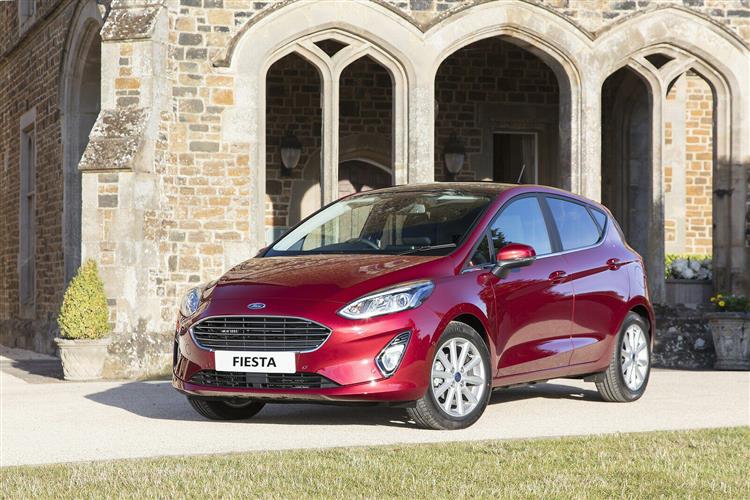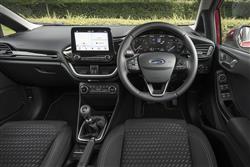MORE REASONS TO JOIN THE FIESTA (some text hidden) --NONE--
By Jonathan Crouch
Introductionword count: 68
This seventh generation Fiesta grew up a bit but it didn't lose the youthful, eager feel that endeared previous generation models to so many supermini buyers. Beneath the smarter styling lies some clever user-friendly technology - and cabin quality that'll make down-sizing into one of these less of a chore. This is how you right a best seller. Let's check out early MK7 models as a used proposition.
Modelsword count: 11
[petrol] 1.1 Ti-VCT, 1.0 EcoBoost, 1.5 EcoBoost / [diesel] 1.5 TDCi
Historyword count: 381
What's been the world's most significant car in the last half a century? This is our nomination, Ford's Fiesta, which in 2017 was rejuvenated in MK7 model guise for a fresh generation of buyers. The figures speak for themselves. This supermini was first launched back in 1976 and by 2017, over 17 million models had been sold, 4.5 million of them in the UK. Which is why, at the time of this MK7 model's launch, to keep up with demand, a Fiesta was rolling off the Cologne production line every 68 seconds. In this country, we bought more than a million examples of the previous MK6 model, which was launched in 2008, and by 2017, had been our market's best selling car for the last eight years. Forget 'Mondeo man'; we are, in short, a nation of 'Fiesta folk'. It's an astonishing success story, particularly given that prior to this seventh generation model's introduction, the only area in which Fiesta models had really excelled was in driving dynamics - usually one of the less important attributes for supermini buyers. You'd certainly have expected that if Ford were going to continue this sales dominance, at least in our market, greater efforts would be needed. Given that, it was somewhat surprising in 2017 to be presented with a seventh generation model that looked so similar to its predecessor. Don't be fooled. The Blue Oval brand changed virtually everything here - and we mean almost everything. Out of around 2,500 parts that are needed to create a Fiesta, only about 200 were carried over. The bodywork was completely new; so was the suspension - and as a result, the driving dynamics are even better than before. There was also a brand new interior fashioned with much higher quality. And buyers got a fresh era of media connectivity and camera-driven safety technology. There was also a much wider choice of derivatives than before, with hot hatches, a super-luxury 'Vignale' version and even a 'Fiesta Active' Crossover model in the mix. This was, in short, on paper at least, a thoroughly well thought out piece of supermini development. The MK7 Fiesta sold in this Form until 2020, when the range was updated with mild hybrid power. But it's the earlier 2017-2020-era models we look at here.
What You Getword count: 408
Everything changed here - but almost nothing was different. If you know anything about this car, then come face to face with it, that might be your first perspective on this seventh generation Fiesta's design - it was certainly ours. Ford certainly could have done something radically new; indeed, in many ways, they did. Dimensionally, after all, this was actually quite a fundamentally altered product, 70mm longer, 13mm wider and 20mm lower than the previous MK6 model, plus virtually every constituent part of the car was different. You can see though, why the brand wanted the look and feel of this supermini to stay much the same. The company's European Design Director Joel Piaskowski said he wanted to evolve the styling in a way that would make it more contemporary without losing the essential 'Fiesta-ness' that customers love. That's what was delivered. Cabin quality was what let down the previous model, with its cheap finishes and confusing button clutter. In contrast, with this MK7 model, there are flush, seamless surfaces, soft-touch plastic coatings and neat splashes of chrome, plus it was all very well screwed together by the factory in Cologne. Other than that, the first thing you'll probably notice is the infotainment system that sprouts in free-standing form from the top of the centre console. The screen options vary depending on the model or options you choose - there are 4.2, 6.5 or, as in the case of top variants, 8.0-inch sizes, all featuring pin-sharp graphics, logical menus and fast processor speeds. And in the rear? Well, if you come to this car fresh from ownership of the previous generation model, then it's likely that you'll view Ford's greater efforts in this part of the cabin in a positive light. There is, after all, 16mm more knee room than there was before, plus the seats are softer and offer greater side-to-side support. Should you be trying a Fiesta having sampled a more spacious supermini rival though - and there are plenty - you'll probably be a little less inclined to be quite so generous. Finally, the boot. That extra body length allowed the cargo area to be 17-litres larger than it was before, with this MK7 model rated at 292-litres for both bodyshapes. That figure is only average by class standards, but if you're able to flatten the 60:40 split-folding rear backrest, you'll free up one of the better total capacity figures in the class - 1,093-litres.
To see the full road test text contact us on 0330 0020 227
Pictures (high res disabled)

.jpg)
|
.jpg)
|
.jpg)
| |||
.jpg)
|
.jpg)
|
.jpg)
| |||
.jpg)
|
.jpg)
|

|
Scoring (subset of scores)
Category: Small Runabouts
| Performance | |
| Handling | |
| Comfort | |
| Space | |
| Styling, Build, Value, Equipment, Depreciation, Handling, Insurance and Total scores are available with our full data feed. | |



